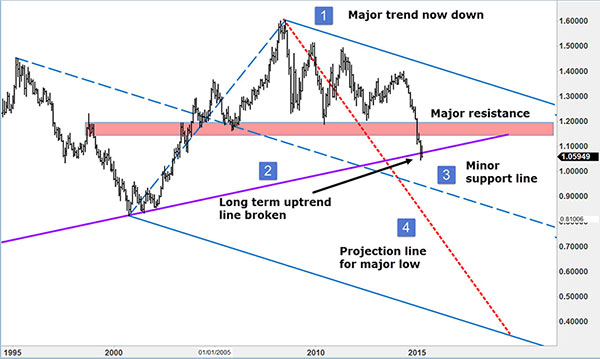
Two months ago in Money and Markets, I alerted you to a troubling trend when U.S. economic reports started taking a turn for the worse, with more negative than positive surprises in the data.
Fast forward eight weeks and the downtrend in our economic data has deteriorated even further, telling me an inflection point for the stock market may be close at hand. Let me explain …
The graph below plots the Bloomberg Economic Surprise Index (ESI: blue line, middle panel), which measures the degree to which recent data has been beating economic forecasts (positive surprises), or falling short (negative). Citigroup produces a similar indicator, which I highlighted in my February article, but both tell the same sad story about the U.S. economy; it’s quickly losing momentum.

Just to recap; the line rises when economic reports are exceeding forecasts, like yesterday’s housing data — a rare positive surprise — but the index declines when data misses projections — last Friday’s disappointing Leading Economic Indicators data, for example.
As you can see above, the data has been falling far short of expectations lately.
In fact, the current trend in the ESI turned negative earlier this year, and hasn’t looked back, recently falling to the lowest level since the 2008 financial crisis!
In other words, the U.S. economy is underperforming by the widest margin since the bull market in stocks began six years ago.
And yet, despite the glaring underperformance of the real economy down on Main Street, you wouldn’t have a clue about this by looking at Wall Street’s performance.
The S&P 500 Index, in spite of volatile up-and-down swings this year, is still less than 2 percent off its record high of 2,119.60 notched in February. What gives?
This is an unusually wide disconnect between real economic performance and investor sentiment, and something’s got to give. The gap between perception and reality, must close sooner or later; either with the U.S. economy improving, or with the stock market declining.
As you can see in the chart above, there has been a very strong link between downturns in the ESI warning of trouble ahead for stocks in the past.
Now, don’t get me wrong; this doesn’t necessarily mean stocks will plunge, but a correction is certainly possible, even overdue at this point. But keep in mind, many of the corrections shown in the S&P 500 chart above were relatively brief and minor pullbacks in price of less than 10 percent.
Bottom line: Now is a good time to be cautious. And you may want to consider grabbing some open gains and/or raising your protective stops. For more aggressive investors, an inverse ETF could provide a hedge to help you profit from a correction.
Above all, keep a watchful eye on trends in the economic data, and in the stock market. If we see a string of better-than-expected data, stocks could move higher again. But watch out if the S&P 500 Index begins following recent economic data to the downside.
Good investing,
Mike Burnick
About Mike Burnick
Mike Burnick, who has over 25 years of professional investment experience, is the editor of the Ultimate Stock Options newsletter and associate editor and trader of Martin’s Ultimate Portfolio.
Mike has been a Registered Investment Adviser and portfolio manager responsible for the day-to-day operations of a mutual fund. He also held the position of investment research analyst and Director of Research for Weiss Capital Management, where he assisted with trading and asset-allocation responsibilities for a $5 million ETF portfolio.












